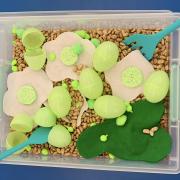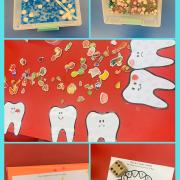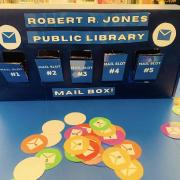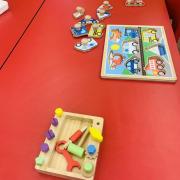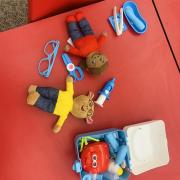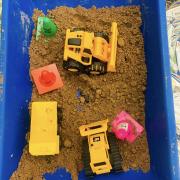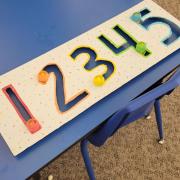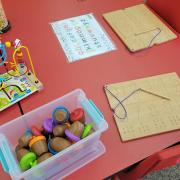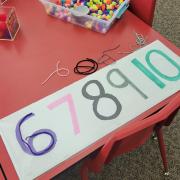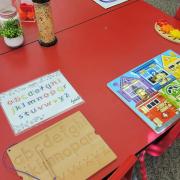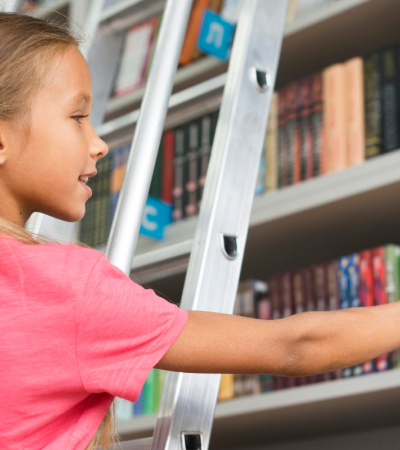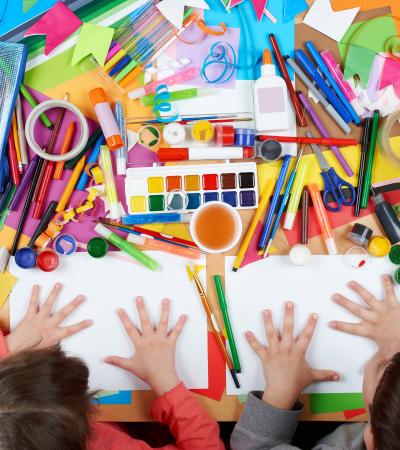This weekly program invites little ones to engage their senses, develop fine motor skills and spark curiosity. Each session is designed to create a delightful sensory experience through a variety of interactive stations.
Designed for toddlers and young children, this program is open to all and aims to be inclusive.
Advanced Planning
The goals for this program were to create an inclusive activity for our patrons while instilling child development skills and community bonding. This program was developed in a month.
We could sense a need for more programming opportunities for our young patrons, but also the flexibility for parents and guardians to be able to connect. The main obstacle when developing this programming was freeing up space within our working areas to allow for storage when the bins would not be in use. The other materials such as busy board puzzles and mats were already available for patrons to check out or play with in the children’s area, so that did not cause concern. Once this part was managed, we were able to pre-prep the items for the event.
Marketing
The promotion for this program was done through social media, posters/fliers at our library and word of mouth at other children’s programs.
Parents and children who regularly came to the weekly Thursday storytime were very intrigued and delighted by the new open play program that would be offered the next day. Most of our patrons who attended the first few Manipulation Stations were ones who attended the storytime. As time went on, more of these patrons shared the program with friends and it has become routine for a lot of these families.
This program was very successful from the start due to the open time frame and passive nature of the interactive play.
Budgeting
When this program was first developed, we already had a good assortment of sensory puzzle boards available for checkout, along with other manipulative items that patrons could passively play with at the library. Knowing this, we based one station table using these puzzles and items in mind. From there we developed the sensory bins.
Contents in each bin will vary in cost or be made with supplies you may already have on hand.
When purchasing the tubs, we made sure it was a stackable storage solution that could fit on our shelves. We started with eight tubs due to having only eight seats available at the table they would be set up on.
Each bin cost was $3 - $5 each. Scoopers and utensil packs can range from $15-$20. The contents of each bin can vary in cost due to themes and amount of items. Often, we try to find base layers that can be homemade or at low cost such as moon sand, rice, beans, pasta, baking soda, cereal sand, beads, cocoa powder, small Styrofoam balls, crinkled paper, pompoms, cotton balls, etc.
Day-of-event Activity
The setup is fairly minimal. Our children’s room layout is set up with three separate tables that sit eight at each table.
The first table is designated with the “messy” sensory bins that are homemade. The second table is set up with our puzzle boards, sensory mats and manipulative toys. The third table is set up for sound instruments and cutting or tracing activities. Finally, we have one large sensory bin that is placed on the center of the rug with a tablecloth underneath to catch any messes.
One staff member sets up the room half an hour before the program and it usually only takes 15 – 20 minutes to place out all the items. Generally, the only challenge is when it is time to clean up. Some of the young patrons have a hard time stopping when time is up. It has become easier over time, especially when we extend the time frame. Clean-up for the staff member can take roughly 30 minutes with putting things away, wiping tables down and vacuuming.
Program Execution
Since this is a weekly program at our library attendance is always high. We can realistically seat 24 patrons at a time. However, due to the natural flow of this program, we have some patrons who will stay the full two hours and others who will come for 30 minutes.
Generally, our attendance ranges from 15 – 50 patrons in the room throughout the program time. Feedback that we have received is positive, and all our patrons who attend look forward to this program every Friday. We have reached so many more families within our area, and have created a wider range of community bonding due to the success of this program.
The outcomes of this programming are so rewarding. Every week we see our young patron’s progression of their emotional, social and developmental skills. We witness so many connections and friendships being made not only with the young patrons but with their guardians as well.
We have noticed an influx in circulation numbers for the children’s area when this program is being held. Due to the amount of success, we have recently offered another version of this program on Saturdays to reach more patrons who can not participate in our Friday program. The evaluation of this program was developed through one-on-one surveys from our patrons, along with tracking the program attendance weekly and running circulation reports.
Advice
If you are interested in implementing this program, I would say start small and build as you go. Don’t be afraid to test new materials and themes. You will come to find that some materials work well together and others don’t. The same goes for themes. We have tied the stations to weekly storytimes, and at other times we just create something more general for the month. It is up to you and how experimental you want to get with it.
This program holds a lot of value if you can connect it to something literary/educational, but just using gross motor skills, and social-emotional learning is more than enough of reason to consider adding this to your events. It will get messy and that is okay because kids are learning and guardians are creating connections with one another. This program will bring your community together!
Supporting Materials
- Feedback (Coming Soon!)
- Programming Librarian Facebook Group






